This iron mounted rifle was probably made in SW Virginia about the 2nd
quarter of the 19th century. The straight barrel is 45 in. long and 7/8th
in. across the flats, about .32 cal.
The 2 screw barrel tang has a finial on the end and is 3 in. long.
There are 4 pipes. The upper pipes are only 1 5/16 in. long.
The nosecap is 1 9/16 in. long.
The handforged buttplate is 4 5/8 in. wide and 1 5/16 in. wide.
The lock is an English trade lock that may or may not be original to the
rifle. It's entirely appropriate to the rifle but has a screw hole filled
forward and appears to have the lockplate tail reduced. On the other hand
the pan lines up perfectly with the vent in the sunset position. The
inletting matches the lock and the sear works perfectly with the set
triggers.
Note the forestock is of a rounded shape. Not V shaped as it might be in
E. Tenn.
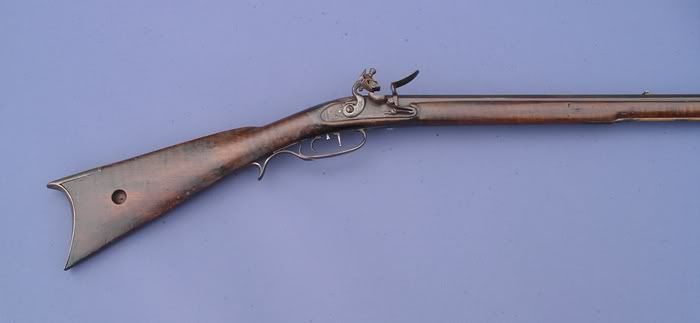
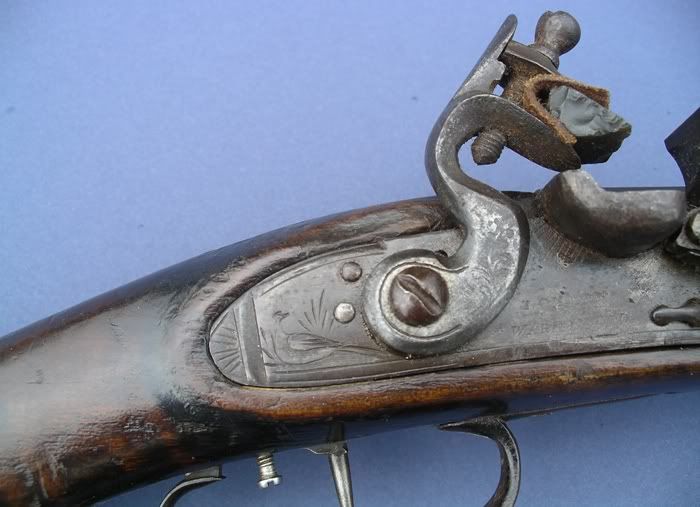
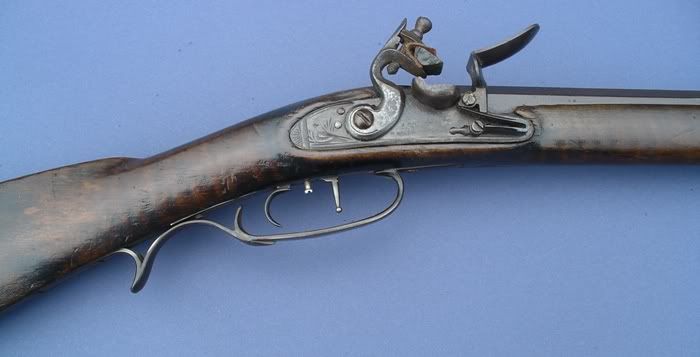

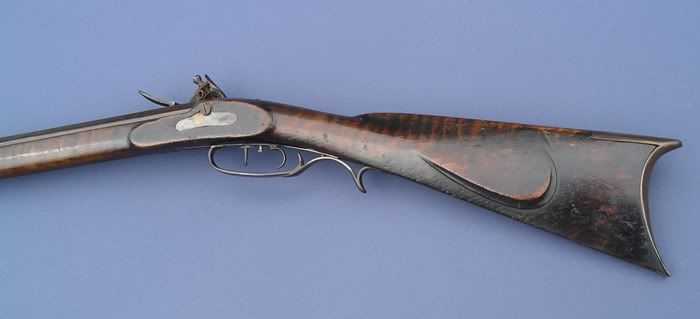
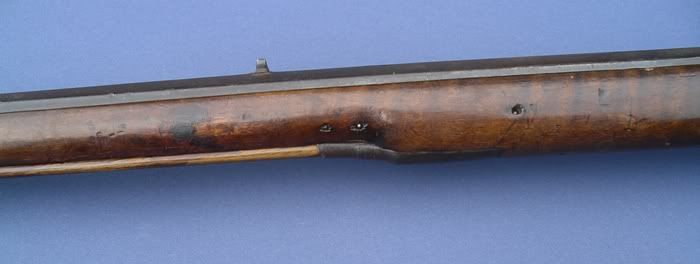
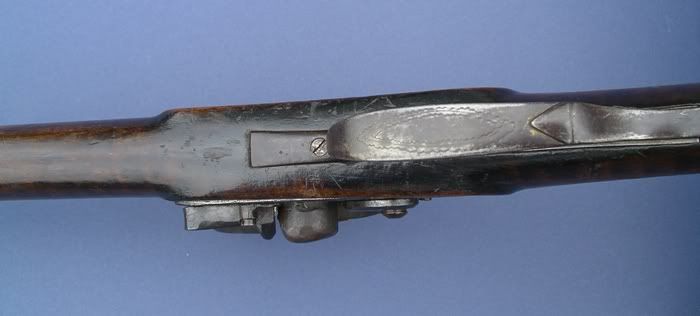

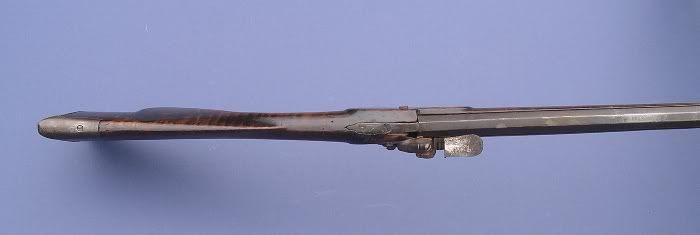
Comments:
Nord, can you clarify if the gun is signed or initialed? Does the barrel have "John Whitesides" engraved on it as stated in the title, or has the owner surmised this from whatever is on the barrel? This gun could also be from Kentucky.
The lock appears to be a modern rework/reshaping of an original plate, made into a less than correct lock for this gun. The pan appears too heavy and incorrect for this type plate, and it has no bridle.
-----------------------------------------------------------------------------------------------
Unfortunately what you see is what I received. If you'd be kind enough to Email your concerns to me, I'll forward them to the owner.
-----------------------------------------------------------------------------------------------
The owner points out that the lock might or might not be original to the gun, so no revelation there. And true, it's a rather poor attempt of conversion to flint.
The gun was obviously percussion for a long time given the burned away wood around the tang and front of the lock, and could have been made originally as a percussion given the single bolt lock plate.
Also, the front trigger and adjustment screw are probably new.
I don't think either of these faults should necessarily disqualify the gun, but I'll leave that decision up to the mountain gun experts.
-----------------------------------------------------------------------------------------------
Afraid I can't add much to what has already been said. It looks very much like the rifle could have been percussion originally, and incorrectly changed over to flintlock. The piece has a lot of style that we all like in the the Southern Rifles. The appearance is that of an old original gun that was doctored in more recent times to improve the look and the value.
------------------------------------------------------------------------------------------------
The gun has sufficient merit as a southen rifle to go to the museum, with appropriate comments. It has good architecture, barrel appears full length based on location of rear sight, neat oval cheekpiece, nice iron mounts, particularly the iron guard with engraved bow. It appears to be a later ca. 1840-1845 percussion rifle in my opinion, with pinned barrel, good drop, nice cresent in butt, and what appears to be original jag, etc.
There were a number of makers in Kentucky with the initials J.W. On a more focused scale, two of them with last name White were Jesse White and J. E. White, and both worked in timeframe and location (southeastern Kentucky) to have possibly made this gun. That's why it's important to know what is on the top barrel flat and how the owner's name was arrived at. If in fact "John Whitesides" is spelled out on the barrel, we probably need to do more work on chasing down the maker.
-----------------------------------------------------------------------------------------------
I had this rifle in my possession for several months. The signature on the barrel is almost worn away. Only parts of it can be seen. The previous owner told me that numerous southern rifle experts had told him it was a John Whitesides rifle. Whiteside lived in the Abbingdon VA area.
While the rifle was in my possession Gerald Neaves told me that the rifle was made by John Whiteside, Gerald was familiar with his work and his signature.
This is all circumstantial evidence but its probably a little more that the current owner can give.
-----------------------------------------------------------------------------------------------
This is basically a pretty nice rifle, it has simply had a little latter day restoration, none of which would keep it out of the Library, in my opinion. If Gerald Neaves believes it to be a John Whitesides rifle, it probably is. The biggest question in my mind is whether or not the rifle actually started life as a flintlock. There were a lot of early percussion rifles "re-converted" to something they never were, by collector/shooters forty or fifty years ago. I still think it belongs in the Library, but I would include the comments along with it.
-----------------------------------------------------------------------------------------------
See the thread
https://americanlongrifles.org/forum/index.php?topic=5625.msg54650#msg54650 for full discussion and photos.
There are several features/characteristics that tell me that this rifle was made by an Indiana maker named Zebadee Wood or by the partnership of Wood and George Proctor. I have photographed several rifles made by the duo and they are signed, "Wood & Proctor" in script. The examples that I have handled are serial numbered and sometimes dated. One example laid across my lap right now is signed, numbered, and dated: "Wood & Proctor No193 AD 1831". The earliest date I have seen on one of their rifles is 1828. the rifle pictured looks "right" to me. I'd be somewhat surprised if there are no signs of a signature on this gun.
The shape and workmanship of the iron triggerguard, triggers, stock architecture, and engraving tell me which maker or partnership produced this rifle.
Wood came to Indiana from North Carolina(where he was likely trained)in 1818.

